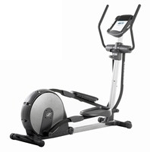 Thought I’d follow up my recent post about home treadmills with a quick post about elliptical cross trainers.
Thought I’d follow up my recent post about home treadmills with a quick post about elliptical cross trainers.
An elliptical trainer looks somewhat similar to a stair climbing machine, and today, home-use ellipticals are becoming almost as popular as treadmills with a wide range of models available. Not surprisingly its action feels like a mix of stairclimbing and cross-country skiing and the only cardiovascular activity that’s more similar to running is pool running.
Pool running is a better choice for runners who have injuries that make it impossible (or inadvisable) to perform any weight-bearing exercise, but elliptical training is better for helping you maintain your body’s impact-absorbing capacity. Remember, elliptical training involves no impact, but it is a weight-bearing activity.
Another great advantage that elliptical trainers have over other exercise machines is that most models work the muscles of both the upper and lower body. This results in a cardiovascular efficiency that produces an equivalent training effect as other forms of exercise, but over a shorter period of time.
If you’re injured and looking to maintain conditioning for a sport, then elliptical trainers can elevate your heart rate quickly and keep you in good cardiovascular condition. For non-athletes looking to stay fit and lose a few pounds, then alternating training days between 20-30 minute sessions on an elliptical trainer and lifting weights will get you to your goal.
If you’ve decided to splash the cash and purchase an elliptical trainer, just make sure it’s manufactured by a reputable company. The number of “budget models” available has risen dramatically over the past couple of years and a rushed purchase could prove to be a costly mistake, both in terms of money and wasted exercise time.
Features to look out for when purchasing an elliptical trainer include the following:
- Upper Body Movement Feel – the handles should be comfortable to grip and without significant play as the handles change direction. Check that at high resistance levels, there’s no rocking or instability.
- Lower Body Movement Feel – the feel of a cross trainer is quite subjective. Ideally it should feel smooth throughout the range of movement, with a natural stride pattern – not jerky or snatchy. The footplate should not change direction suddenly as it reaches the end of the ellipse.
- Braking System – almost all elliptical trainers use magnetic braking.
- Ellipse Stride Length Adjustment – some high-end machines allow you to shorten or lengthen the stride, making it easier to match the machine’s movement to your own natural stride pattern.
- Console Feedback/Ease Of Use – how clear and comprehensive is the displayed information? How easy is it to access built-in programmes? Are buttons visible and easy to use?
- Workload – how much workload can the elliptical provide when used flat out? If you’re fit look for at least 250 watts.
- Elliptical Programmes – some can offer variety and motivation by simulating various hill courses, allowing you to create your own or by controlling your heart rate.
- Power type – some elliptical trainers are self-powered whilst others require a mains connection.
Good luck with your purchase and happy cross training!
